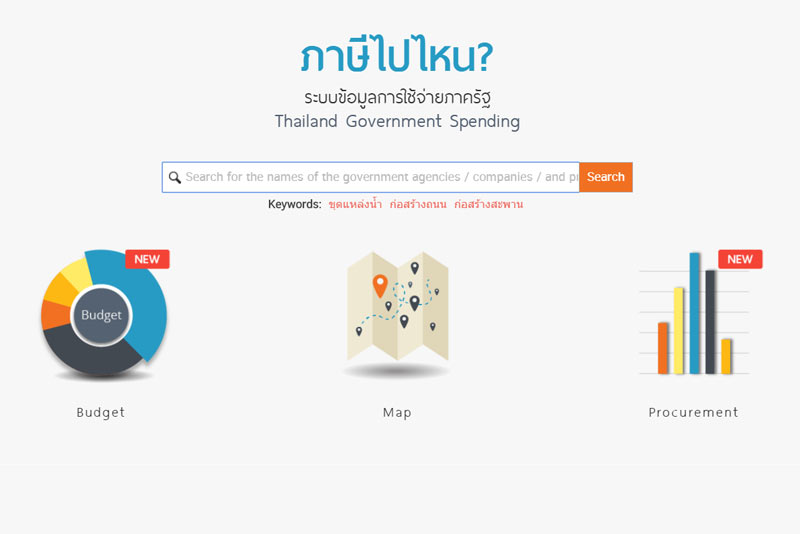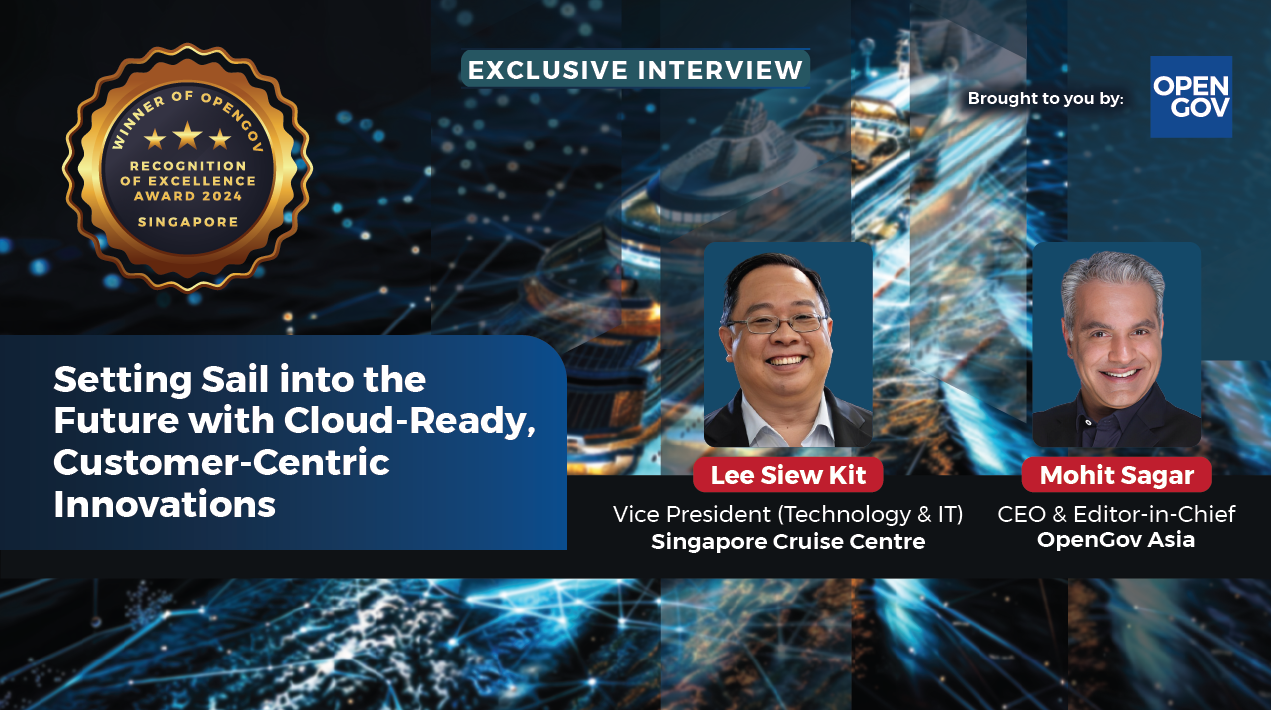
As Thai
citizens are obliged to pay direct and indirect taxes to the Thai government, we
always ask ourselves, “How
does the government spend my taxes for my or the country’s benefits?” or in
short “Where do our taxes go?”.
Before 1997, it had
been virtually impossible for ordinary Thai citizens, businesses or civil
society organisations to acquire the details about more than a million procurement
projects from numerous government agencies, which constitute a considerable proportion of Thailand’s government
expenditure. Citizens who were interested in the data needed to find out first
and foremost an agency responsible for each procurement project. Then, they
needed to travel to that agency and request the data which could still be
denied. Furthermore, government agencies could still charge fees to citizens at
their discretion. Such
complicated processes made access to government procurement data unaffordable
for ordinary citizens, and they were excluded from political participation and
anti-corruption missions.
The situation was better when the Official
Information Act B.E. 2540 (1997) came into
force at the end of 1997. The Act requires government agencies to disclose
their information to the general public
including the information on their concession contracts, agreements of a
monopolistic nature or joint venture agreements with private individuals for the
provision of public services. It is considered as the significant milestone for
the revelation of how the Thai government spent taxpayers’ money in the modern
era. In case a government agency refuses to provide the information for
citizens, they can appeal to the Information
Disclosure Tribunal. Since 1999, in which the Administrative Court was
established, citizens who are denied access to government information can also
bring the cases to the Administrative Court. Moreover, in 2011 the Cabinet required all government
agencies to disclose their public information via their digital channels such
as websites to make it easier for Thai people to access the information. Also, the
Organic Act on Counter-Corruption (No. 2) B.E. 2554 (2011) requires all
government agencies to reveal reference prices of government procurement
projects and how they are calculated via electronic means.
Despite
the regulations and efforts of many governments to enhance government’s transparency, some major obstacles still
exist. First, some government agencies still disclose their information in a
paper-based format at their information centers. Citizens therefore still need
to travel to each information center around the country to collect the
information which is impossible. Second, each government agency discloses the
information on their procurement projects separately on their own websites. It
means that if citizens want the comprehensive information, it is necessary for
them to visit more than thousands of websites of government agencies at the central,
provincial and local levels which is extremely inconvenient and time-consuming.
Third, the information presented on each website is designed for government
officials and academics who have profound knowledge of the government
procurement regulations and processes or private enterprises which desire to
offer their products and services to government agencies.
As a consequence of these major
obstacles, not only are average Thai
citizens prevented from easy and convenient access to government procurement information,
they are also excluded from political participation and anti-corruption
missions. Political inequality in Thailand was widened by the complicated
processes of access to government procurement information.
Thailand
Government Spending Initiative as a digital solution for ordinary citizens
The current government led by Prime
Minister Prayut Chan-o-cha is strongly committed to corruption elimination. The
first critical success factor is to enable ordinary citizens to access
government procurement information with minimal limitations. The National
Counter Corruption Commission set up by the government resolved in 2015 to push
for opening data on government procurement to the general public via a single
digital channel in an easy-to-understand format. To turn the resolution into
reality, the Electronic Government Agency (EGA) has been working
collaboratively with many related agencies responsible for government budget
and procurement such as the Bureau of the Budget within the Prime Minister’s
Office portfolio and the Comptroller General’s Department within the portfolio
of the Ministry of Finance to develop the “Thailand Government Spending”
Initiative, commonly known as “Where do our taxes go”?. The website, https://govspending.data.go.th/,
is therefore created as the single portal website to reveal government
procurement information in a format which ordinary citizens can access and
understand with only their fingertips.
The initiative utilises reliable
primary data from the e-Budgeting of the Bureau of the Budget, the e-Government Procurement
(e-GP) and the Government Fiscal Management Information System
(GFMIS) of Comptroller General’s Department, which are already revealed via a
digital means, to perform data analytics and present it in easy-to-understand
formats such as dashboards, maps and infographics.
Citizens with only basic knowledge of
government procurement processes and basic computer skills can visit the
website and understand the information easily. The information is continuously
updated when a contract between a business enterprise and a government agency
is signed. Ordinary citizens can see an overview of the government budget
allocation, government spending strategies and how the overall budget is
actually spent with only few clicks.


Citizens
can also access the details of government procurement projects in each province
by clicking on the map. For example, in Chiang Rai Province in the northern
part of Thailand, there were 36,505 government procurement projects in Fiscal
Year 2016 from 931 government agencies with the total budget of 8,007.34
million baht.

The significant details of each
procurement project presented on the website include the
responsible agency, the project title, the project number, the reference price,
the budget allocated for the project, the agreed price, the procurement method,
the details of the contractor, the date on which the contract is signed and
terminated and the project status. Currently, a mobile application is available
for citizens to be downloaded from both iOS and Android.
Moreover,
people can also search for a specific perspective of the government procurement
information from its smart search engine. They can type the names of government
agencies, private enterprises or areas in which procurement projects take
place. The information will appear in the blink of an eye.
With
up to date details available for them in only few clicks, if citizens suspect
or find delays, frauds or corruption in any projects, they can lodge formal
complaints to the Office of the Public Sector Anti-Corruption Commission or the
Office of the Prime Minister conveniently.
In
the future, the Thai government plans to expand the information to be revealed
on the Thailand Government Spending initiative to cover taxes and other sources
of revenue collected by the government.
When the next phase of the initiative
is complete, it will become the most comprehensive reliable source of
information for Thai citizens to scrutinise how the Thai government collects
and spends people’s taxes for the benefits of the country.
Not
only notable features of the Thailand Government Spending initiative do help
remove obstacles to government procurement information access, they also
empower ordinary citizens of all socio-economic statuses to scrutinise the
government with dignity leading to more inclusive and effective political
participation in the country.
Conclusion
Before
the Thailand Government initiative was developed in 2015, it was extremely
difficult for ordinary Thai citizens to obtain the comprehensive information on
government procurement. The initiative revolutionises how the government
reveals the information to the general public. Instead of waiting for the
people to request the government procurement information, the initiative
optimises and integrates reliable data from government agencies, performs data
analytics and presents it in easy-to-understand formats including dashboards,
maps and infographics via a single digital channel. The initiative becomes the
digital innovation which enables ordinary citizens of all socio-economic
statuses to access and understand the information with minimal limitations and
therefore empowers them to scrutinise how the Thai government spends their
taxes for their benefits.
Author’s note: I owe a
deep debt of gratitude to the
executives of the EGA including Dr. Sak Segkhoonthod, Mrs. Airada Luangvilai, Ms. Apinhporn Aungkhagamonsesth and Mrs. Suppawan Taraphokakul for their generous and continuing support. I also wish
to thank my colleagues who have provided valuable feedbacks and comments
including Ms. Wannee Sutthirojaumpai, Mr. Attasit
Sermtanawisan and Ms. Tarnwimon
Siriruangampai.
Read the two-part OpenGov interview with Dr. Sak Segkhoonthod, President and CEO of EGA: Part 1 and Part 2.
















